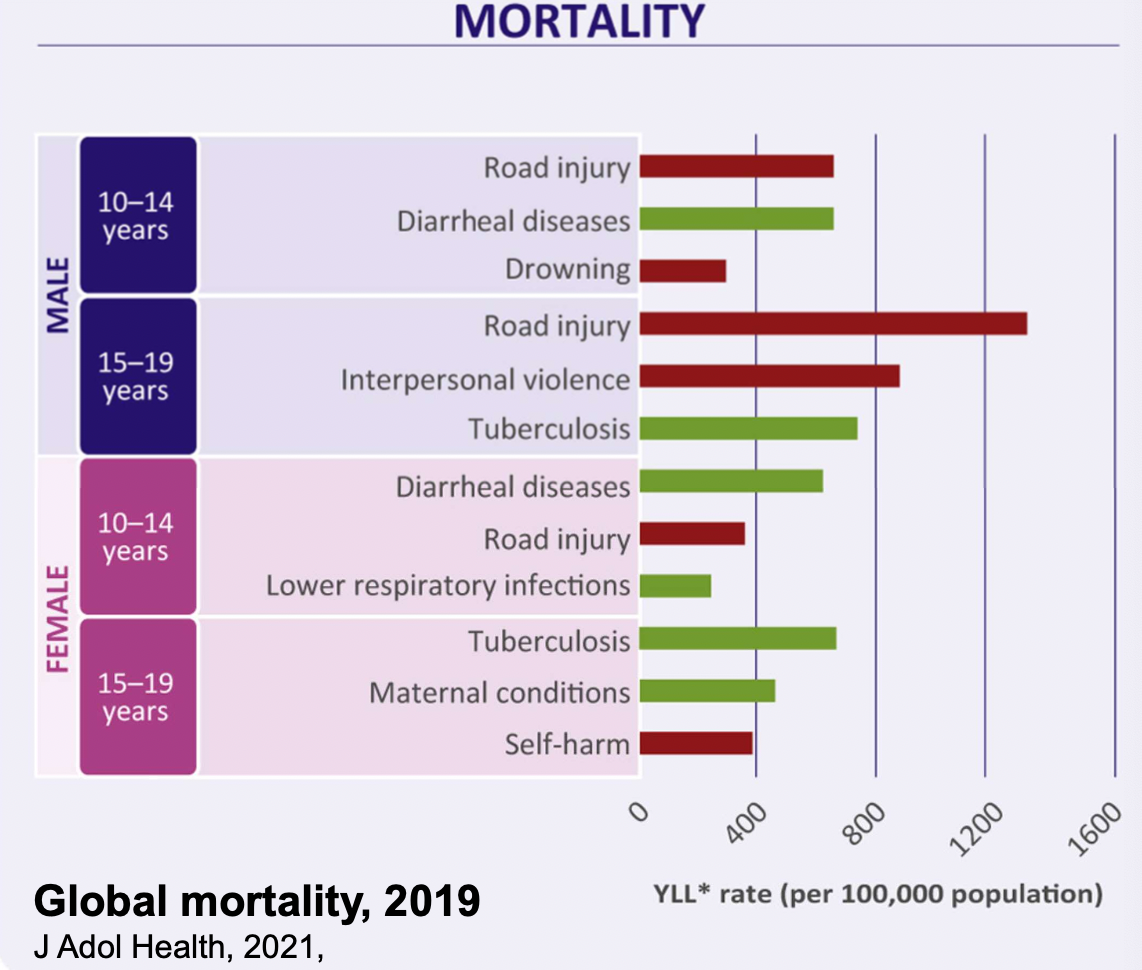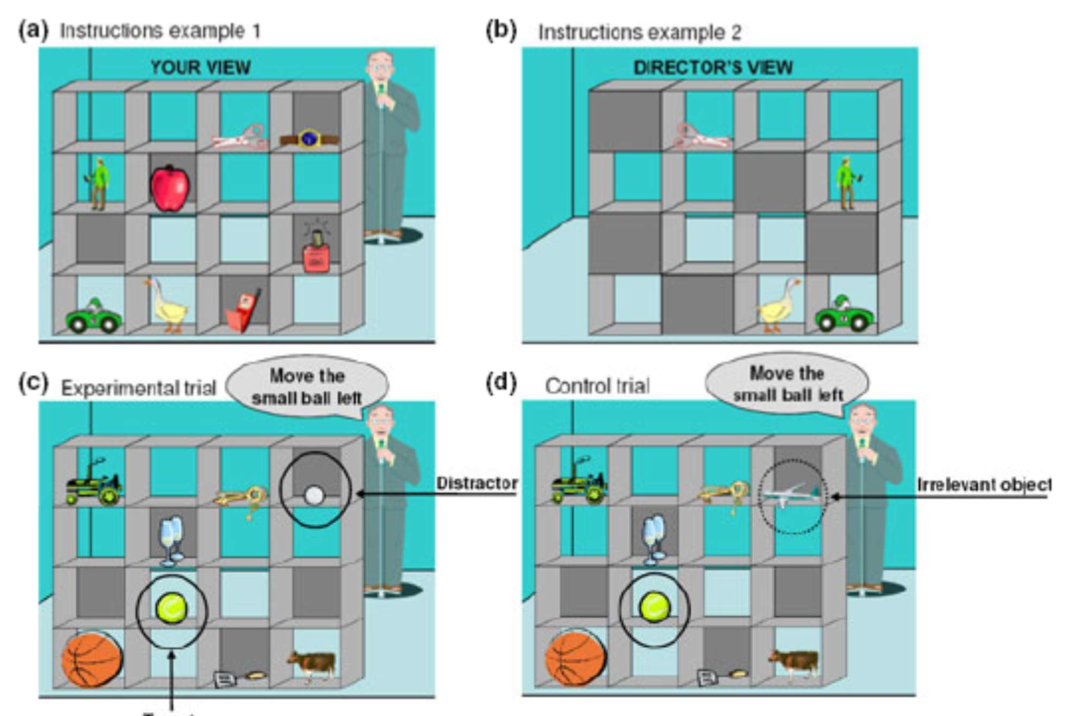ECB 2 Lecture 1
1/22
There's no tags or description
Looks like no tags are added yet.
Name | Mastery | Learn | Test | Matching | Spaced |
|---|
No study sessions yet.
23 Terms
Adolescence
Phase distinct from childhood and adulthood – universal
Onset and end – culturally specific
Onset: puberty
End: achieving full adult roles
Mortality in adolescents
Increase in age through risk taking behavior → unintentional injuries (traffic accidents)
Especially in boys

Mental health in Western adolescents (11-19)
Mental disorders tend to begin in youth (less chance of having mental disorders in adulthood if you do not have them in adolescence)
Episodes of mild DSM-IV mental disorder are common
22% of the adolescents experienced at least one severe disorder; 10% had poor mental health
The prevalence of severe mental disorder in adolescents is higher than even the most prevalent major somatic conditions
Major risks but still major opportunities in adolescence
Start of adolescnece: Puberty
Start with bodily changes triggered by hormones → Gonadotropin-releasing hormone
This increases luteinizing hormone and follicle stimulating hormone
These hormones trigger the rise of testosteron in boys and estradiol and progesterone in girls
End of adolescence: Adult role
End of adolescence when you take on adult roles → can be culturally specific
Usually richer adolescence take on adult roles later → longer adolescence
Longer duration of adolescence → longer period of risks and opportunities

Puberty and the brain
Long-term process
Hormones influence how the brain is organized (e.g., testosterone leads to increase in grey matter in medial amygdala)
Hormones influence the way that brain cells become activated in response to a situation or environment (e.g., testosterone increases during a fight; mice who win a fight develop more receptors for testosterone in brain regions that are important for reward and social behavior)
Structural brain changes during adolescence
Gray matter tends to thin
White matter increases in volume
Functional connectivity changes
Neurons/synapses first proliferate, and then are pruned
More than 40% of synapses are eliminated
Changes in frontal/basal ganglia circuits

Functional brain changes during adolescence
Cognitive control: both increases and decreases in prefrontal activation during adolescence; increases in parietal cortex
Affective processing: nonlinear pattern with peak in subcortical processing in mid-adolescence
Social-cognitive processing: gradual increase in TPJ, gradual decrease in dmPFC (anterior-posterior shift) from adolescence to adulthood
Social-affective processing: increased response to acceptance and rejection
Dual process models
Mismatch between increased sensitivity to emotional stimuli in limbic areas and delayed maturation of cognitive control
Individual differences influencing adolescence
Genetic and environmental factors
Neurocognitive development
Mental health
Social cognition
Face / emotion recognition
Empathy
Perspective-taking / theory of mind
Social decision-making (trust)
Face recognition in adolescence
Face perception (identity) and face memory improve during adolescence
Female > male in face memory but not perception
Compared to adults, looking at emotional (fearful) faces elicits more brain activity, which is less influenced by top-down control
Development of empathy
Increases in adolescence
Advantage in females (at least to self-report)

Perspective-taking during adolescence
Increases in adolescence
Even adults have problems with it → depends on cognitive effort

Development of trust in adolescence
The trust game: willingness to invest money depends on trust that the other will return (some)
Trust increases over adolescence and life (incline again later in adulthood)
You become more trustworthy over life
Increasing ability to distinguish between social and selfish partners (van den Bos et al, 2010)
Increasing ability to integrate partner’s responses with a priori information (Lee et al, 2016)
Social cognitive development: Summary
Basic skills are in place before adolescence
Face/emotion processing: dip in early adolescence; gradual increase in capacity to modulate emotion processing
Self-reported empathy: gradual increase; gender difference (F>M)
Perspective-taking: gradual increase in usage of other persons perspective
Trust: gradual increase in use of both actual feedback and a priori information
Peer relations in adolescence
Social evaluation
Social influence
Social exclusion
Sensitivity to social evaluation
N=69
fMRI, camera off, warming up or projecting image to a peer → peer watches you being scanned
More self-reported embarrassment, arousal, mPFC activation, and striatum – mPFC connectivity in adolescents compared to children and adults
Adolescent risk taking
Increase in young adolescences
Increase when peers are watching
No gender differences

Social influences and body image
Norm-deviating feedback on ideal body image resulted in activity in ACC-insula network in young females (18-19 years)
This effect was stronger for females with low self-esteem
Rating was adjusted in the direction of group norm
Social rejection and the brain
Measured using cyberball paradigm
First included, then excluded from the game
Reported exclusion-related distress
Three age groups: young adolescent, mid adolescent, adult females
Exclusion influences mood in YA and MA
Exclusion triggers anxiety in YA
Activation in insula and subACC related to self-reported distress
Activation in subACC associated with increase in depressive symptoms (CBCL) at 1-year follow-up
Sustained activation in dorsal ACC in youth with major depression - link to rumination?
Social rejection and the behavior
Young adolescents predicted that they would be liked less frequently
Young adults overestimated the extent to which they would be liked by peers
Young adolescents felt worse about themselves after rejection
Young adults preserved positive self-views
Young adolescents maintained impressions of peers regardless of peer feedback
Young adults updated impressions of peers based on whether that peer accepted or rejected them
Adolescents more likely to expect and internalize negative judgments
Adults use self-protective strategies:
Expect to be liked
Maintain positive self-view after rejection
Dislike source of negative feedback
From the adolescent perspective, social risk may be more harmful than health and saftey risks